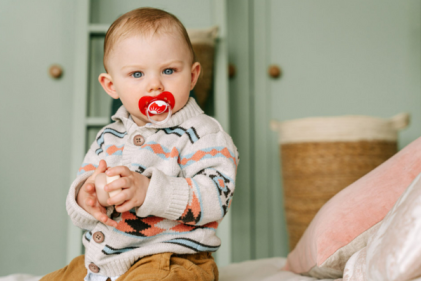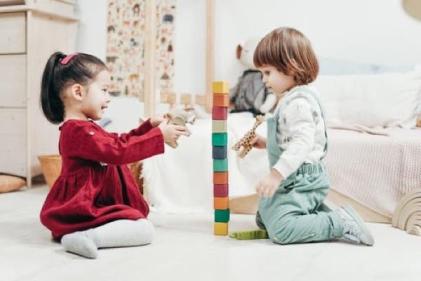
Sleep is one of the most common concerns for parents of young children. Whether you are a first-time parent or have a growing family; along with feeding and making sure our children are healthy and happy, encouraging your children to sleep is a challenge! It is a topic of conversation that can dominate our lives, particularly if a parent is finding it hard to establish a sleep routine or would like their baby to sleep through the night – both which can be tricky to achieve!
It’s important to note that every child is different, and what may work for one family may not be the best option for others; but once we find what works, it can make our little ones sleeping more comfortable and content! Here are some great positive sleep habits that parents can start from early on with their child.
How sleep works
Both adults and children sleep in very similar ways. Sleep cycles are pretty much the same for every child from about three to four months of age. During the course of the night, we follow a particular rhythm and pattern; for example, when we fall asleep, we often enter into a light sleep for 15 to 20 minutes. During this stage, the brain can be as busy as it is during the day. We also dream during this time, too! It’s then followed by a deep sleep of up to three hours – this is when lots of our energy is restored, and tissue growth and repair occur.
Both children and adults change from light to deep sleep cycles for the remainder of the night, waking briefly when changing from one to the other. It’s during this time that we might turn over in the bed or pull over our covers, and very quickly return to sleep. Most children wake up a couple of times during the night too, or at least go through periods of light sleep where they may wake up more easily. It’s great if your child is able to go back to sleep by themselves; however, if they can’t, this is usually when they will call out for a parent to help them go back to sleep.

Look for signs of tiredness
If we want to encourage sleep in small babies and young children, we first need to look for the signals of them feeling tired or sleepy, and then act on it. For young babies, they often appear agitated when they are tired, rubbing their eyes, yawning or even crying.
For toddler-aged children and older ones, they tend to yawn and rub their eyes, but tiredness can also affect their behaviour. They can be more irritable or oppositional.
Small children are not necessarily good judges of their own tiredness level, and many times they will keep going until they are simply exhausted. Often, for babies and young children, they become over-tired where they have the typical signs alongside a burst of energy, or gain a second wind; as a result, they will ‘fight’ sleep and have difficulty settling and going to sleep. If this second wind can be avoided, you may find your child will settle to sleep a lot easier.
The recommended time for a child to be in bed asleep is ideally from between 7-8pm. Remember to avoid any busy music, screen-time or active play near to bedtime and, likewise, sweet foods or tea drinks; these often will prevent a child from settling to sleep.
Encouraging routine
As parents, we know how much young children thrive from routines – they are predictable and consistent! This is one of the biggest positive sleep cues we can give our children. In other words, we can provide the child with a message that it is bedtime. After your baby reaches six months, you may like to start a regular bedtime, leading up to it with a bath, a feeding, and maybe story time. Parents initiate this new routine, as children are led by the adult through encouragement and positive direction.
It’s always helpful to decide on the time you start the bedtime – typically an hour to give everyone a chance to get ready. Remember to name each stage too, even if your child does not have the language. If they are old enough, ask for their help in remembering what happens next - bath time or hands, face, teeth, toilet, preparing bedroom, story time, cuddles - reflect on your day, and tuck into bed. With time, you can encourage this behaviour, and this bedtime routine will become more established, and your child will know the cues and what is expected of them.

What’s the difference between a sleeping aid and a comforter?
Sleep aids and comforters are both helpful for aiding a baby or child to sleep, but they work in very different ways! Sleeping aids are like rocking or feeding a baby until they are sound sleep. Using the motion of a car or buggy until the child is asleep, and then being moved to their cot or bed all require your attention; often, these are the reasons children frequently wake up during the night - they just need the help of the parent to go back to sleep again. This is one of the most common issues for parents.
However, a comforter or a positive sleeping cue like a blanket, soother, thumb, a label, holding a cover or a teddy, is anything a child has or can do to help them go back to sleep by themselves. As the name suggests, it is something that provides comfort, which the child can easily find themselves when they wake in the middle of the night or between sleep cycles. It’s usually from the age of one that some children will become attached to a teddy or blanket, and you may like to encourage this as a potential comforter.
Every family situation when it comes to bedtimes, settling, sleeping or frequent waking is so different to others. If you do find yourself in a place where you’ve done everything you can but need that extra support, there are many sleep consultants available to assist and support you with a tailored plan of action that will take you through those sleepless nights to sleeping through.
Aoife Lee, Parent Coach for Giraffe Childcare






